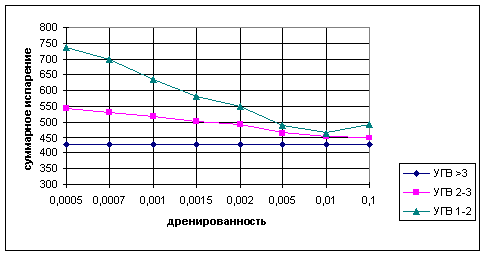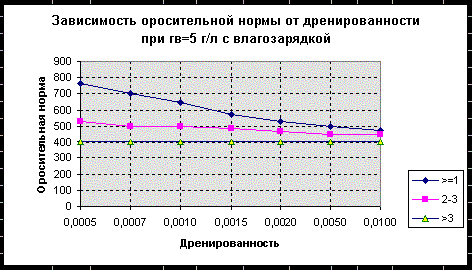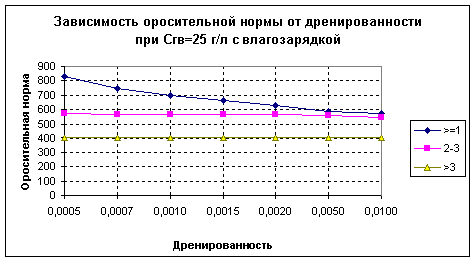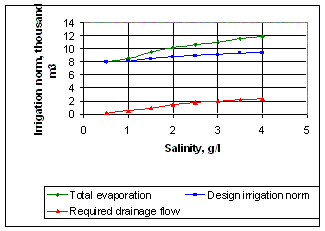Yu.I.Shirokova,
A.N.Morozov
ON
ALLOWING FOR DRAINAGE DEGREE AND MINERALIZATION
OF IRRIGATION WATER WHEN DESIGNING IRRIGATION REGIMES
Abstract:
In the article, the results of moisture-salt transfer processes modeling
are brought made in order to study mechanisms of irrigation regime
change depending on drainage degree of a territory and mineralization
of irrigation water.
Introduction:
Modern methods of definition of crop irrigation regimes commonly do
not take into account the factors indicated in the title of the article,
although their effect is obvious and is corroborated by a number of
theoretical investigations and experiments.
Drainage degree of agricultural lands has a substantial effect on
moisture and salts dynamics in the zones of soils aeration and lower
layers. This phenomenon is qualitatively considered under the natural
conditions by distinguishing between zones of auto-morphic, semi-automorphic
(semi-hydromorphic) and hydromorphic regimes of soil moistening. There
is no sense in more separate division, since for even these, significantly
different regimes, there are no data related to their effect on evapotranspiration
and salt regime.
It is still more difficult to forecast the change of water-salt regime
for artificially irrigated areas, as for normal growth of plants it
is important not only moisture quantity in soil, but also its mineralization
in individual stages of the plant growth. To assess quantitatively
the effect of drainage rate (its ability to drain certain water amount
a time unit by head unit) in the situation considered, let us apply
the soil water-salt regime forecast model approved for Central Asia
[1] that is based on the theory of moisture-salt transfer in soils.
By drainage degree, in this case, is understood capability of drainage
to carry certain water amount from one square meter area to one meter
of head with the accepted in the model linear dependence of the drainage
flow upon the head:
─ = ─Ņ
*(hd. - h),
here: ─ - drainage flow;
─Ņ - drainage degree;
h - groundwater table;
hd - drainage location depth.
Strategy
of investigations:
The particularity of the model [1] used in the forecasts is that in
it moisture-salt transfer processes in an aeration zone are considered
along with moisture transfer in the lower layers (making allowances
for their hydro-geological features - conductivity, head). The model
was adjusted to forecast moisture-salt transfer at irrigation regime
during a vegetative period that is made automatically coming from
agrotechnical demands for moisture and salt-contents of a root-inhabited
layer of one or another crop. In order to estimate total effect of
those two factors on the growth and development of plants, an existing
hypothesis is applied in the model, according to that the action of
osmotic component of the total moisture potential in soil is equivalent
to the effect of a capillary-sorption component [2-5].
In the first forecast series, the influence of different drainage
degree was studied at three groundwater table locations. At that,
stable (in long-term context) water-salt regime of the aeration zone
was kept automatically, which completely met existing agritechnical
requirements.
Forecasts were made for two contrast cases - relatively fresh groundwater
(5 g/l by solid residue) and highly mineralized (25 g/l). The second
part of the investigations was dedicated to studying the influence
of mineralization degree of irrigation water on irrigation rate size
and their components.
One should specially note, that we forecasted values of water and
salt net balances' components of, and this means that subject to irrigation
technique applied, all the investigation results must be corrected
by the values of surface and deep discharges characteristic of one
or another irrigation method.
Investigation
results:
The first part of the investigations was carried our for cotton crop
on typical soils of middle-loamy granulometric structure for the central
climatic zone (C-II-A according to the classification of the Central
Asian National Design Institute of Water and Cotton Sredazghiprovodkhlopok).
In picture 1, forecasted water losses to evapotranspiration (total
evaporation a year, mm) are compared, with keeping given agritechnical
modes in the conditions being considered at the drainage degree of
0.0005 to 0.1 m3/m2, that is virtually from hydromorphic to automorphic
conditions.
The results achieved testify that with transfer from automrphic to
semi-hydromorphic and hydromorphic conditions, keeping the set conditions
range of water-salt regime in a root-inhabited layer makes for, with
alternative variants for the plants, different evapotranspiration,
the more the higher hydromorphic degree and lower drainage degree.
Apparently, that should be expected, since at such a transfer the
average moisture rises in a soil's root- inhabited layer and, correspondingly,
the total evaporation does, too. Consequently, consumption of irrigation
water increases to keep the set water-salt regime.

Figure
1. Forecasted variation of annual values of evapotranspiration depending
on drainage degree and hydro-geological conditions in the case of
high-mineralized water (25 g/l).
On figures
2 and 3, change of irrigation rate with irrigated area's drainage
degree is shown.

Figure
2. Dependency of the annual irrigation rate (with moisture-charging
irrigation) on the drainage degree of irrigated area for the conditions
of the C-II-A climatic zone. Irrigation water mineralization čŅ =
1 g/l, one of groundwater - čgw = 5g/l.

Figure
3. Dependency of the annual irrigation rate (with moisture-charging
irrigation) on the drainage degree of irrigated area for the conditions
of the C-II-A climatic zone. Irrigation water mineralization čŅ =
1 g/l, one of groundwater - čgw = 25 g/l.
The second
part of the investigations was carried our for cotton crop on typical
soils of middle-loamy granulometric structure for a climatic zone
(U-I-A according to the classification of the Central Asian National
Design Institute of Water and Cotton Sredazghiprovodkhlopok), characteristic
of the Karshi Steppe. Let us consider how irrigation rates of crops
and their components vary depending on irrigation water mineralization.
In that series of forecasts, in the above-mentioned model, a drainage
degree level was accepted close to the design set for the conditions
of the Golodnaya, Djizzak and Karshi steppes (0.001 m3/m2). During
that series of forecasts, stable (in long-term context) water-salt
regime of aeration zone was automatically kept, completely meeting
existing agritechnical requirements despite different mineralization
of irrigation water, thanks to automatic correction of irrigation
terms according to the total soil moisture potential's value in root-
inhabited layer of soil.

Figure
4. Variation of irrigation rate's components depending on irrigation
water mineralization for the U-I-A climatic zone (Karshi steppe).
These forecasts unambiguously allow making a series of conclusions:
maintenance of given water and salt regimes of soil when using high-mineralized
water causes evapotranspiration to rise due to increase of the average
moisture of root- inhabited layer and amount of drainage flow for
keeping salt balance.
Conclusion: the forecast calculations performed allow valid
correcting irrigation rates of crops subject to design drainage degree
of agricultural lands and irrigation water mineralization.
References:
1. A.N.Morozov, V.A.Zlotnik. Estimation of usability of high-mineralized
water for cotton irrigation. Collection of research works of SANIIRI
(Central Asian Research Institute for Irrigation) and Sredazghiprovodkhlopok
(Central Asian National Design Institute of Water and Cotton). Tashkent,
1983, pp.80-90.
2. čampbell R.B., Bower C.A., Richards L.A., Change of electrical
conductivity with temperature and the relation of osmotic pressure
to electrical conductivity and ion concentration for soil extracts,
Proc. Soil Sci. Am., 13, 1949 p.66-69.
3. R.Slatcher. Water regime of plants. Moscow, "Mir" publication
house, 1970, p.365.
4. K.A.Black. Plant and soil. Moscow, "Kolos" publication
house, 1973, p.503.
5. Y.I.Shirokova, A.N.Morozov. On the role of moisture-charging irrigation
in increase of water supply to irrigated fields. Water resources of
Central Asia. Alma-Ati, 2002. Pp.312-320.
Return
to the main page
How
to connect to us

